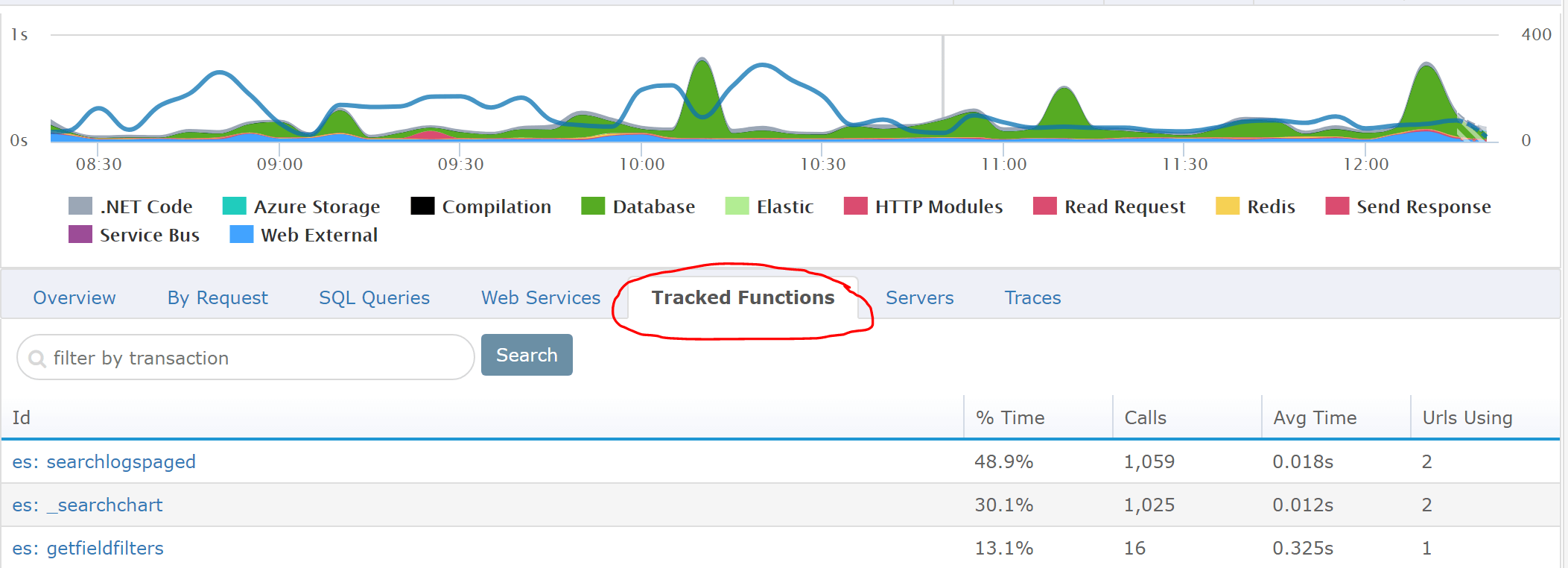
By TechnologyAzure and AWS Monitoring
By IndustryIntegrates with your stack
By InitiativeEngineering & DevOps Teams
TechnicalIt’s easy to get the help you need

Our goal at Stackify has always been to provide developers a simple way to monitor the performance of their applications. By default, Retrace tracks the performance of dozens of different common application dependencies and frameworks. This includes things like SQL databases, MongoDB, Elasticsearch, Redis, external REST services, and much more.
Full list of supported frameworks: .NET or Java
But what if you want to track something else?
This is where Tracked Functions is really powerful.
There are probably endless ways you could use Tracked Functions. I can think of three different categories that they should all fall under.
Retrace automatically tracks how long web requests take (and non-web with a little work). But what if you want to break that down further?
Let’s pretend you have a web application that receives uploaded files and processes them.
If you wanted more granularity around how long step 1 takes, tracked functions could help. All you would need to do is tell Retrace to track that block of code. Retrace would then report every time it happens and how long it takes. This would give you better visibility in to know how long that specific step of the entire process takes.
Retrace automatically tracks dozens of common application dependencies. However, it will never support everything.
Let’s pretend you are writing a .NET application that uses OpenTSDB for storing time series data. You could use Tracked Functions to track the usage and performance of it.
Retrace provides great reporting around SQL queries. Unfortunately, that doesn’t work for things like Elasticsearch or MongoDB (at this time).
At Stackify we use Elasticsearch and wanted to report around how often we call specific queries and how long they take. We are able to accomplish this with Tracked Functions.
Our code that executes searches against Elasticsearch is in a central location. With a couple lines of code, we were able to instrument our code and report our queries to Retrace.
The implementation is a little different depending on which programming language you are using.
To utilize Tracked Functions, you must add our StackifyLib nuget package to your project. You then surround your code as shown below with our tracer.
var tracer = StackifyLib.ProfileTracer.CreateAsTrackedFunction("Name the block of code");
tracer.Exec(() =>
{
//Do some stuff
});
For Java, you can implement Tracked Functions by decorating the methods in your code or via a configuration file. See our docs for more details.
{
"Class": “com.company.SampleController",
"Method": “testMethod",
"TrackedFunction": true,
"TrackedFunctionName": "Tracked Function Test {{ClassName}}.{{MethodName}}"
}
Within the application dashboard for each of your applications, you can access Tracked Functions. It will show a list of all the Tracked Functions currently being tracked for your application.

If you select a specific web request or transaction, you can then see how that tracked function impacts the performance of that request.

You can also see the tracked functions within the traces that are collected.

Retrace provides a wide array of application monitoring capabilities. Tracked Functions allows you to get very granular in tracking the performance of your code. Hopefully, this article gives you a good review of why you would use them and some of the benefits.
Stackify's APM tools are used by thousands of .NET, Java, PHP, Node.js, Python, & Ruby developers all over the world.
Explore Retrace's product features to learn more.
If you would like to be a guest contributor to the Stackify blog please reach out to stackify@stackify.com